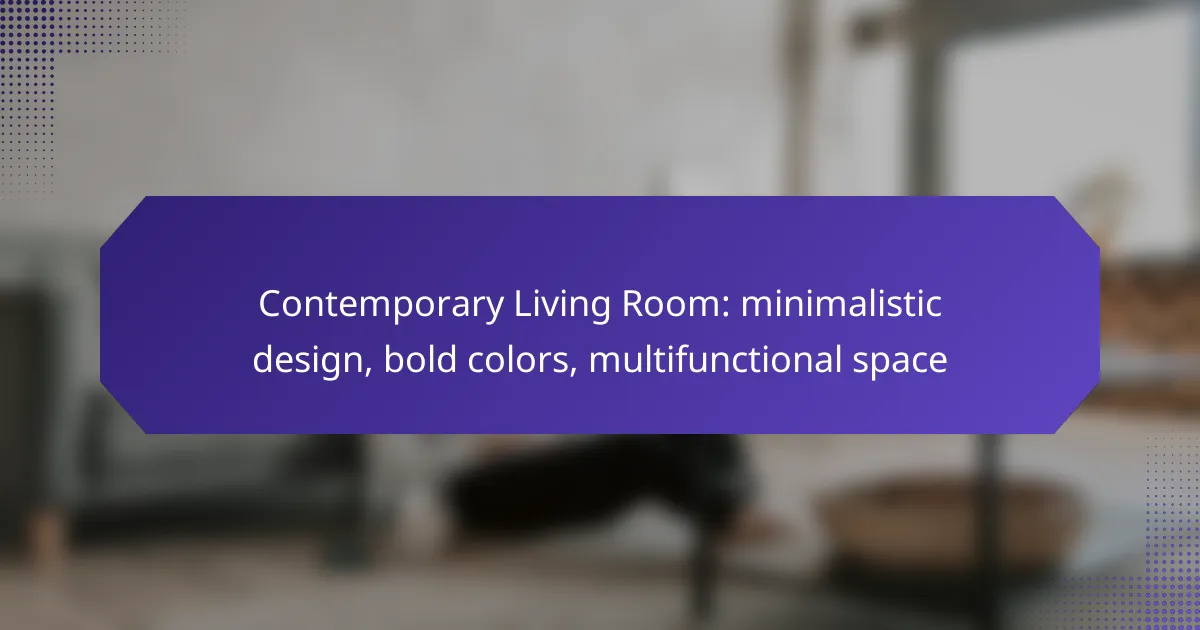A contemporary living room designed with minimalistic principles emphasizes simplicity and functionality, creating a serene environment. By incorporating bold colors, such as deep blues or vibrant yellows, the space gains character while remaining uncluttered. Additionally, a multifunctional layout allows the area to serve various purposes, enhancing both practicality and style.

How to design a minimalistic living room in Canada?
To design a minimalistic living room in Canada, focus on simplicity, functionality, and a cohesive color scheme. This approach emphasizes clean lines and practical furniture choices while incorporating bold colors to create a striking yet uncluttered space.
Focus on clean lines and simplicity
Clean lines are essential in minimalistic design, creating a sense of order and tranquility. Choose furniture and decor with straight edges and smooth surfaces to maintain a streamlined look. Avoid ornate details that can clutter the visual space.
Consider using a limited number of furniture pieces that serve specific purposes, ensuring each item contributes to the overall aesthetic. For example, a sleek sofa paired with a simple coffee table can create a focal point without overwhelming the room.
Incorporate neutral color palettes
Neutral color palettes are foundational in minimalistic living rooms, providing a serene backdrop. Shades like whites, grays, and beiges allow bold accent colors to stand out without competing for attention. This balance creates a harmonious environment.
To add depth, consider layering different textures within the neutral palette, such as a soft wool rug or linen curtains. This approach maintains simplicity while enhancing visual interest, making the room feel inviting and comfortable.
Utilize multifunctional furniture
Multifunctional furniture is key in maximizing space in a minimalistic living room. Look for pieces that serve dual purposes, such as a sofa bed or an ottoman with storage. This strategy helps reduce clutter while providing essential functionality.
In smaller Canadian homes, consider foldable tables or nesting side tables that can be easily stored when not in use. This flexibility allows you to adapt the space for various activities, from entertaining guests to enjoying a quiet evening at home.
Maximize natural light
Natural light enhances the minimalistic aesthetic by making spaces feel larger and more open. Use sheer window treatments to allow sunlight to filter in while maintaining privacy. This approach brightens the room and highlights the clean lines of your design.
Position mirrors strategically to reflect light and create the illusion of more space. A well-placed mirror can double the effect of natural light, making your living room feel airy and expansive, which is particularly beneficial in the often gray Canadian winters.

What bold colors work well in contemporary living rooms?
Bold colors can significantly enhance the aesthetic of contemporary living rooms by creating focal points and adding vibrancy. Popular choices include deep blues, vibrant yellows, and rich greens, each offering unique benefits and styles that complement minimalistic designs.
Deep blues for accent walls
Deep blue is an excellent choice for accent walls in contemporary living rooms, as it adds depth and sophistication. This color pairs well with neutral tones, allowing furniture and decor to stand out without overwhelming the space.
When using deep blue, consider the room’s lighting. Natural light can soften the intensity, while artificial lighting may require lighter furnishings to balance the darker hue. A good rule of thumb is to use deep blue on one wall to create a striking focal point.
Vibrant yellows in decor
Vibrant yellow can infuse energy and warmth into a contemporary living room. This color works well in decorative elements such as cushions, artwork, or rugs, providing a cheerful contrast to more subdued colors.
To effectively incorporate vibrant yellow, aim for accents rather than large surfaces. A few well-placed yellow items can brighten the room without overwhelming it. Pair yellow with grays or whites for a balanced look that maintains a modern feel.
Rich greens for plants and textiles
Rich green is ideal for adding a touch of nature to contemporary living rooms. Incorporating plants or textiles in shades of green can create a calming atmosphere while enhancing the room’s overall aesthetic.
When selecting green elements, consider using a variety of textures, such as soft cushions or leafy plants, to add dimension. This approach not only brings life to the space but also complements the minimalistic design by keeping the focus on natural beauty.

How to create a multifunctional living space?
Creating a multifunctional living space involves designing an area that serves various purposes while maintaining a cohesive aesthetic. This can be achieved through smart furniture choices, effective storage solutions, and clearly defined activity zones.
Use modular furniture for flexibility
Modular furniture allows for easy reconfiguration to suit different activities or gatherings. Pieces like sectional sofas, ottomans, and stackable chairs can be rearranged to create more space or accommodate larger groups.
When selecting modular options, consider materials that are durable and easy to clean, especially in high-traffic areas. Look for items that can serve multiple functions, such as a coffee table that doubles as storage or a sofa bed for guests.
Incorporate storage solutions
Effective storage is essential in a multifunctional living space to keep it organized and clutter-free. Utilize built-in shelves, under-sofa storage, and decorative baskets to maximize space without sacrificing style.
Consider vertical storage options to save floor space, such as wall-mounted shelves or tall bookcases. This approach not only provides ample storage but also draws the eye upward, making the room feel larger.
Designate activity zones
Creating distinct activity zones helps define the purpose of different areas within your living space. For example, you might have a reading nook with a comfortable chair and lamp, a workspace with a desk, and a relaxation area with a TV.
Use rugs, furniture arrangement, or lighting to visually separate these zones. This not only enhances functionality but also adds depth and interest to the overall design. Aim for a balance between open space and defined areas to maintain flow and accessibility.

What are the key elements of minimalistic design?
Minimalistic design focuses on simplicity and functionality, stripping away unnecessary elements to create a clean and uncluttered space. Key elements include a limited color palette, functional furniture, and an emphasis on open spaces.
Emphasis on functionality
In minimalistic design, every item must serve a purpose. Furniture should be multifunctional, such as a coffee table that doubles as storage or a sofa bed for guests. This approach not only maximizes space but also enhances the overall utility of the living area.
Consider incorporating pieces that can be easily moved or reconfigured to adapt to different activities, like entertaining or relaxing. Look for items that combine aesthetics with practicality, ensuring that each piece contributes to the room’s overall function.
Use of negative space
Negative space, or the empty areas around objects, is crucial in minimalistic design. It helps to create a sense of openness and tranquility, allowing the eye to rest and the mind to feel less cluttered. By strategically placing furniture and decor, you can enhance the flow of the room.
To effectively utilize negative space, avoid overcrowding surfaces with decor. Instead, choose a few statement pieces that draw attention while leaving ample space around them. This balance creates a harmonious environment that feels both spacious and inviting.
Selection of quality materials
Choosing high-quality materials is essential in minimalistic design, as they contribute to the overall aesthetic and durability of the space. Opt for natural materials like wood, stone, and metal, which not only look sophisticated but also age well over time.
When selecting materials, consider their texture and color to maintain a cohesive look. For instance, a polished wooden table paired with soft textiles can create a warm yet modern feel. Investing in quality materials may have a higher upfront cost, but they often lead to long-term satisfaction and reduced maintenance.

How to choose the right furniture for a minimalistic living room?
Selecting the right furniture for a minimalistic living room involves focusing on pieces that enhance comfort and functionality while maintaining a sleek aesthetic. Look for items that serve multiple purposes and incorporate bold colors to create a striking yet uncluttered environment.
Prioritize comfort and utility
Comfort should be at the forefront when choosing furniture for a minimalistic living room. Opt for sofas and chairs that provide adequate support while allowing for relaxation. Multifunctional pieces, such as ottomans that double as storage, can maximize utility without sacrificing style.
Consider how each piece will be used daily. For example, a coffee table that can expand for dining or a sectional sofa that can be rearranged for gatherings enhances both comfort and practicality.
Opt for furniture with clean silhouettes
Minimalistic design thrives on simplicity, so choose furniture with clean lines and uncluttered forms. Look for sofas, chairs, and tables that have a streamlined appearance, avoiding overly ornate designs. This approach helps maintain an airy feel in the living space.
Neutral colors can complement bold accents, allowing the furniture to blend seamlessly with the overall design. For instance, a white or gray sofa can serve as a perfect backdrop for vibrant throw pillows or artwork.
Consider sustainable materials
Sustainability is increasingly important in furniture selection. Look for pieces made from eco-friendly materials such as reclaimed wood, bamboo, or recycled metals. These options not only reduce environmental impact but also add unique character to your living room.
When shopping, check for certifications like FSC (Forest Stewardship Council) to ensure that the materials are sourced responsibly. Investing in sustainable furniture can enhance your living space while supporting environmentally conscious practices.

What are the benefits of a minimalistic living room?
A minimalistic living room offers numerous benefits, including a serene atmosphere and efficient use of space. By focusing on essential elements and bold colors, this design approach creates a multifunctional area that enhances both comfort and style.
Enhanced tranquility and relaxation
A minimalistic living room promotes tranquility by reducing visual clutter and distractions. With fewer items in the space, your mind can focus on relaxation, making it an ideal environment for unwinding after a long day.
To achieve this calming effect, consider using a neutral color palette combined with bold accent pieces. This contrast can create a striking yet peaceful ambiance, encouraging a sense of calm and comfort.
Improved organization and cleanliness
Minimalistic design inherently encourages better organization and cleanliness. By limiting the number of furnishings and decor, it becomes easier to maintain a tidy space, which can positively impact your overall mood and productivity.
Incorporate multifunctional furniture, such as storage ottomans or coffee tables with hidden compartments, to maximize space efficiency. This approach not only keeps your living room organized but also allows for quick and easy cleaning, making it a practical choice for busy lifestyles.










